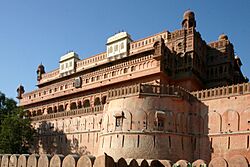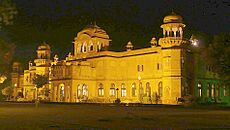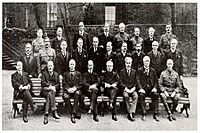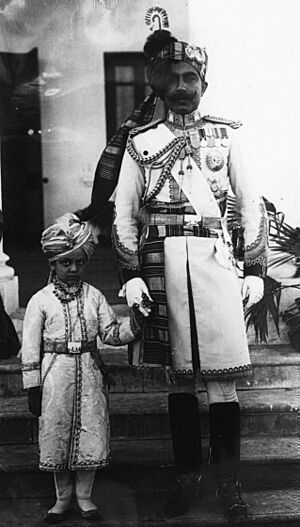History of Bikaner facts for kids
The region of Bikaner is in the north-western part of Rajasthan state in India. Long ago, it was known as Jangladesh. This area included what are now the districts of Bikaner, Churu, Ganganagar, and Hanumangarh. It was surrounded by other regions like Marwar, Jaisalmer, and Ajmer-Merwara.
Bikaner state was a princely state, which means it was a kingdom ruled by a local prince under the larger rule of an empire. It was started in the 15th century. In 1818, it became a British protectorate, meaning it was protected by the British but still had its own ruler. Bikaner remained a state until India became independent in 1947.
| History of Bikaner | |
| Location | North-western Rajasthan |
| 19th-century flag | |
| State established: | 1488 |
| Language | Rajasthani language |
| Dynasties | Rathores (1488–1949) |
| Historical capitals | Bikaner |
Contents
The Founding of Bikaner
Before the mid-15th century, the Bikaner region was a dry, wild place called Jangladesh. This changed when Rao Bika founded the city of Bikaner in 1488. Rao Bika was the son of Rao Jodha, who founded the city of Jodhpur.
Rao Bika's Journey
Rao Bika decided to create his own kingdom after a small disagreement with his father. He left Jodhpur with his uncle, Kandhmal. On his journey, Bika visited the mystic Karni Mata in Deshnoke. She gave him her blessings and told him he would succeed.
Encouraged by her support, Bika used the disagreements among the local Jat people to establish his own territory. He chose the "Jangladesh" region of Rajasthan. Even though it was in the Thar Desert, Bikaner was important. It was like an oasis because it had enough spring water. This made it a good stop on the trade route between Central Asia and the Gujarat coast.
Building the City and Fort
The city and state were named Bikaner, meaning "the settlement of Bika." Rao Bika built a fort in 1478, but it is now in ruins. About a hundred years later, a new fort was built. This new fort, called the Junagarh Fort, is about 1.5 kilometers from the city center.
Bikaner Under Mughal Rule
About a century after Rao Bika founded Bikaner, the state became very successful. This happened under the sixth Raja, Rai Singhji, who ruled from 1571 to 1611.
Raja Rai Singh's Contributions
During the time of the Mughal Empire in India, Raja Rai Singh made an alliance with the Mughals. He became an important army general for Emperor Akbar and his son, Emperor Jahangir. Rai Singh was a very successful military leader. He even helped the Mughal Empire gain half of the Mewar kingdom.
Because of his success, the Mughal emperors gave him special lands called jagirs in Gujarat and Burhanpur. He used the money from these lands to build the Chintamani Durg, which is now known as Junagarh Fort. This fort was built on a plain about 760 feet (230 meters) high. Rai Singh was also interested in arts and architecture. Many buildings inside the Junagarh Fort show the knowledge he gained from his travels.
Later Rulers and Fort Additions
Later rulers also added to the fort. Maharaja Karan Singh (1631–1669) built the Karan Mahal palace. Future rulers added more floors and decorations to this palace. Anup Singh (1669–1698) made many additions to the fort. He built new palaces and the Zenana quarter, which was a special living area for royal women and children. He also updated the Karan Mahal with a public audience hall called Diwan-i-Am and renamed it Anup Mahal. Maharaja Gaj Singh (1746–1787) improved the Chandra Mahal, also known as the Moon palace.
Bikaner and the British
In the 18th century, there were wars between the rulers of Bikaner and Jodhpur, and also among other local chiefs called thakurs. British troops helped to end these conflicts in the 19th century.
Becoming a British Protectorate
Maharaja Surat Singh ruled from 1787 to 1828. He decorated the audience hall with glass and colorful paintings. In 1818, during his rule, Bikaner signed a treaty with the British. This meant Bikaner came under the suzerainty (protection and control) of the British. After this, the Maharajas of Bikaner spent a lot of money improving Junagarh Fort.
Dungar Singh, who ruled from 1872 to 1887, built the Badal Mahal, or 'weather palace'. It was named this because it had a painting of clouds and falling rain, which is a rare sight in dry Bikaner.
Maharaja Ganga Singh's Era
General Maharaja Ganga Singh ruled from 1887 to 1943. He was one of the most famous princes of Rajasthan and was well-liked by the British Viceroys. He was given the title of Knight Commander of the Order of the Star of India.
Maharaja Ganga Singh was very important on the world stage. He was a member of the Imperial War Cabinet and represented India at conferences during World War I. He also represented the British Empire at the Versailles Peace Conference after the war.
He made many improvements to Junagarh Fort. He built separate halls for public and private meetings in the Ganga Mahal. He also built a durbar hall for formal events. He built the Ganga Niwas Palace, which has towers at its entrance. He also built the Lalgarh Palace in honor of his father. He moved his main home from Junagarh Fort to Lalgarh Palace in 1902. The hall where he celebrated his 50th year as ruler (in 1938) is now a museum.
Accession to India
Maharaja Ganga Singh's son, Lieutenant-General Sir Sadul Singh, became Maharaja in 1943. When the British left India in 1947, Bikaner became an independent state. Maharaja Sadul Singh chose for his state to join the Union of India. He was one of the first rulers to sign the Instrument of Accession on August 7, 1947. Bikaner then became part of the state of Rajputana, which was later renamed Rajasthan.
Maharaja Sadul Singh passed away in 1950. His son, Karni Singh (1924-1988), took over the title. The Royal Family still lives in a part of Lalgarh Palace, which they have turned into a heritage hotel.
Rulers of Bikaner
The rulers of Bikaner belonged to the Rathore clan. Here are some of the important rulers:
| Name | Reign Began | Reign Ended | |
|---|---|---|---|
| 1 | Rao Bika | 1472 | 1504 |
| 2 | Rao Narayan Singh | 1504 | 1505 |
| 3 | Rao Luna Karana | 1505 | 1526 |
| 4 | Rao Jait Singh | 1526 | 1541 |
| 5 | Rao Kalyan Mal – Accepted the rule of Emperor Akbar | 1541 | 1574 |
| 6 | Rao Rai Singh – An important General in the Mughal army | 1574 | 1612 |
| 7 | Rai Dalpat Singh | 1612 | 1613 |
| 8 | Rai Surat Singh Bhuratiya | 1613 | 1631 |
| 9 | Rao Karan Singh – Removed from power by Emperor Aurangzeb | 1631 | 1667 |
| 10 | Maharaja Rao Anup Singh – First to be called 'Maharaja' by Emperor Aurangzeb | 1669 | 1698 |
| 11 | Maharaja Rao Sarup Singh | 1698 | 1700 |
| 12 | Maharaja Rao Sujan Singh – Faced invasions but successfully defended his state | 1700 | 1735 |
| 13 | Maharaja Rao Zorawar Singh | 1735 | 1746 |
| 14 | Maharaja Rao Gaj Singh – First to be allowed to make his own coins | 1746 | 1787 |
| 15 | Maharaja Rao Rai Singh II | 1787 | 1787 |
| 16 | Maharaja Rao Pratap Singh | 1787 | 1787 |
| 17 | Maharaja Rao Surat Singh – Signed the treaty with the East India Company | 1787 | 1828 |
| 18 | Narendra Maharaja Rao Ratan Singh – Helped the British during the First Afghan War | 1828 | 1851 |
| 19 | Narendra Maharaja Rao Sardar Singh – Helped the British during the Indian Uprising of 1857 | 1851 | 1872 |
| 20 | Narendra Maharaja Rao Dungar Singh – Helped the British during the Second Afghan War | 1872 | 1887 |
| 21 | General Narendra Maharaja Sir Rao Ganga Singh – Served in World War I and signed the Treaty of Versailles | 1887 | 1943 |
| 22 | Lieutenant-General Narendra Maharaja Sir Rao Sadul Singh – Signed the agreement to join India | 1943 | 1950 |
| 23 | Rao Karni Singh – Member of Parliament, last ruler to receive royal payments | 1950 | 1971 |





